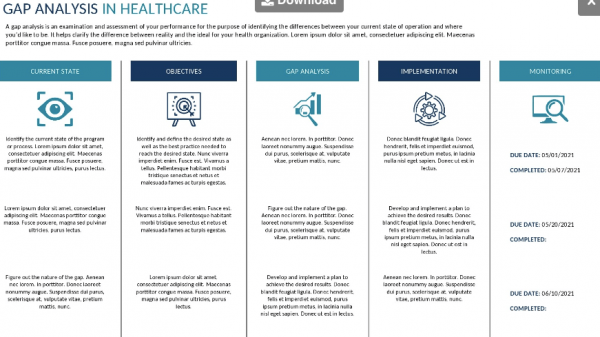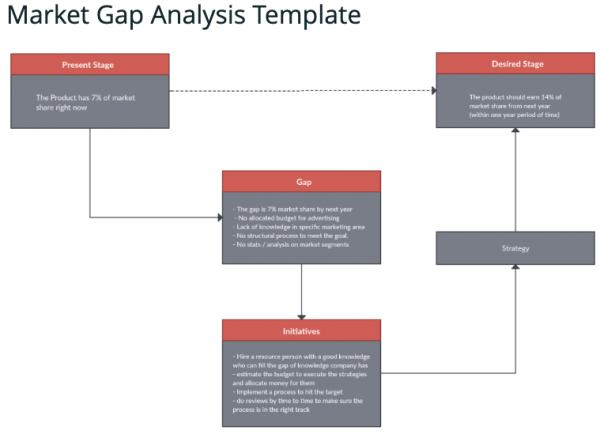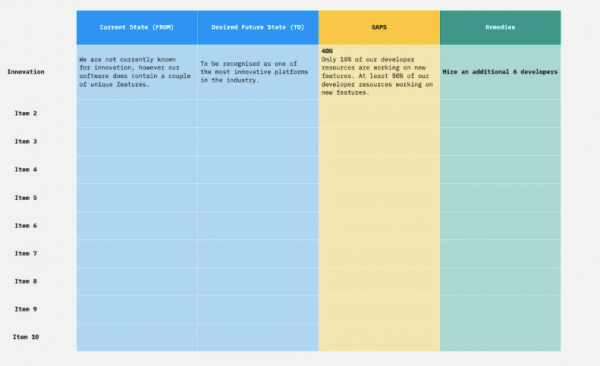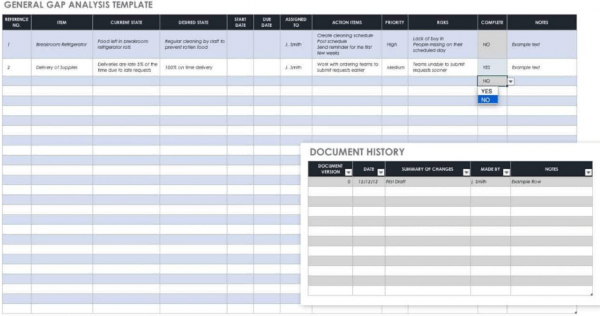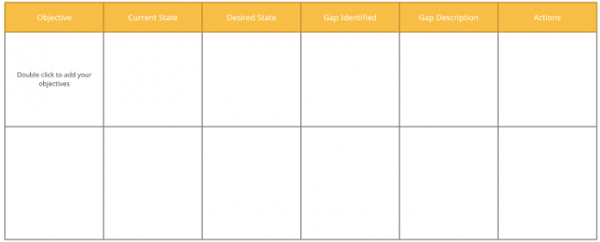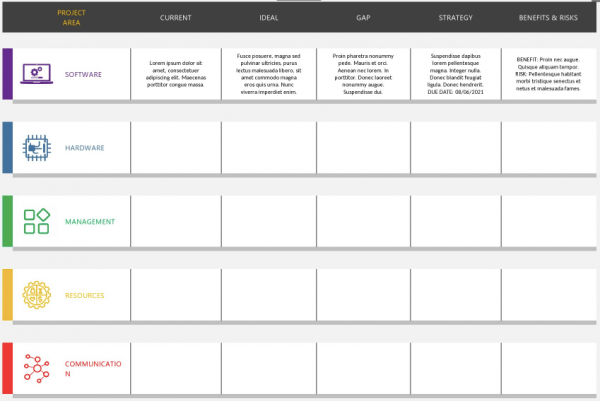Gap analysis assesses the difference between the current state of an organization, project, or process and the desired future state. It is used to identify areas where improvement is needed and to develop a plan to improve performance. There are many different types of gap analyses, but they all share the same goal: to identify areas in need of improvement and to develop a plan to address those needs.
A gap analysis is a valuable tool that can be used to assess the difference between the current state of an organization, project, or process and the desired future state. It can help organizations to identify areas where improvement is needed and develop a plan for how to improve performance.
While there are some potential drawbacks associated with conducting a gap analysis, such as time and cost, these should be balanced against the potential benefits. There are many different types of gap analyses, but they all share the same goal: to identify areas in need of improvement and to develop a plan to address those needs.
Importance of Gap Analysis In Project Management
It is important because it clearly outlines the main topics by narrowing them enough to understand why a project or process is not meeting its objectives. And the most important thing is what can be done, for example in a practical way you will:
- Identify which areas of the project or process need to be improved
- Develop a plan for how to improve performance
- Measure progress towards goals
Components Of Gap Analysis
There are four main components:
- Goal setting: Goal setting helps to identify the specific goals of the project and what needs to be done to achieve them.
- Data collection: Data collection involves gathering information about the current state of the project.
- Data analysis: Data analysis is used to identify the gaps between the current state and the desired future state.
- Action planning: Action planning helps to develop a plan to close the identified gaps.
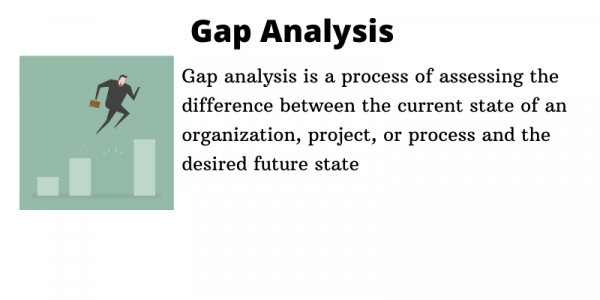
How To Conduct Gap Analysis
Gap analyses can be conducted on individual projects, programs, or organizational units, and can be tailored to specific needs. For example, a gap analysis can be used to assess an organization’s project management processes, IT systems, or startup procedures. There are several steps involved:
Defining the goals and objectives of the analysis
First, you need to clearly define your goals and objectives. What are you trying to achieve?
This step when conducting a gap is to define the goals and objectives of the analysis. This will help to ensure that all stakeholders are clear on what is being assessed and why it is essential.
Identifying the current state
Once the goals and objectives have been defined, the next step is to identify the current state. This can be done through research, interviews, surveys, or other methods. It is important to gather data from multiple sources to get a well-rounded view of the current state.
You will need to gather data from a variety of sources. This will help you get a clear picture of the gap.
Identifying the desired future state
The next step is to identify the desired future state. This step can be completed by holding brainstorming sessions with stakeholders or by conducting research on best practices in other organizations
Identifying the gap between the current and desired states
After the current and desired states have been identified, it is time to identify the gaps between them. This can be done by comparing the data gathered in steps two and three and identifying where there are discrepancies.
Developing a plan to close the gap
Finally, once all of the gaps have been identified, it is time to develop a plan to close them. This plan should be tailored specifically to each organization and should take into account both short-term and long-term goals. You need to involve all stakeholders in the process. This will help ensure that everyone is on the same page and that the final results are achievable.
Examples of Gap analysis
The following are five gap analysis examples. This lists the situations where it can be helpful:
- When starting a new project: It can be used to assess an organization’s current project management practices and identify areas in need of improvement. This type of analysis can help ensure that a new project is started on the right foot and that key processes are put in place from the beginning.
- When implementing new software: It can help identify potential issues that may arise when new software is implemented. This type of analysis can help ensure a smooth transition and prevent any disruptions to business operations.
- When launching a new product: It can help identify any potential problems that may occur during the launch of a new product. This type of analysis can help ensure a successful launch and prevent any delays or setbacks.
- When expanding into new markets: It can help assess an organization’s readiness for expansion into new markets. This type of analysis can help identify any areas in need of improvement and ensure that all necessary steps are taken before expansion occurs.
- When reorganizing an organization: It can help assess an organization’s current state and identify areas that need to be addressed during the reorganization process. This type of analysis can help ensure that all necessary changes are made and that the reorganization is successful.
Best Practices When Doing Gap Analysis
Conducting a gap analysis can be a daunting task, but following these best practices will help you get the most out of the process. Remember the purpose of a gap analysis is to identify the gaps between the current state and the desired future state. So try to be concise when helping your organization to attain specific goals.
These are a few BEST practices to keep in mind when conducting a gap analysis:
- Define the end goal– What are you trying to achieve? What are you trying to assess? What time period are you looking at? What stakeholders are involved? Answering these questions will help to ensure that your gap analysis is focused and on track.
- Conduct a thorough analysis– This means looking at all aspects of the current state and the desired state. You should use a variety of data sources in order to get a well-rounded view of the situation. This could include surveys, interviews, financial data, customer data, etc. The more data you have, the more reliable your results will be.
- Be realistic- It is important to be realistic about what can be accomplished and what gaps exist. You should make sure to use the most up-to-date data possible. This will help to ensure that your results are relevant and can be used to make rational decisions based on facts.
- Create a plan– Once the gaps have been identified, create a plan to close those gaps.
- Implement the plan– This is the most important step! Without implementation, the gap analysis is pointless.
Drawbacks Of Gap Analysis
While there are many benefits associated with conducting a gap analysis, there are also some potential drawbacks, including:
- Time – Conducting a comprehensive gap analysis can be time-consuming
- Cost – Hiring consultants or using specialized software can increase the cost of conducting a gap analysis
- Complexity – Gap analyses can be complex, especially if there are multiple stakeholders involved
- Resistance – Some stakeholders may resist change if they feel threatened by the results of the gap analysis
FAQs
What is a Gap analysis?
It is an essential tool for understanding what needs to be done to close the gap between where you are now and where you want to be with your business and organization. Once the gaps have been identified, the project manager can develop a plan of action to address them.
Why is it important for an organization to do a Gap Analysis?
Conducting a gap analysis is an important part of any project or process improvement initiative. By taking the time to assess the current state and identify areas for improvement, organizations can focus their efforts on making changes that will have the biggest impact.
What comes next after a gap Analysis?
The next step is to implement the plan of action and work to close the gaps. This may involve changes to the project scope, resources, timeline, or other factors. By taking action to close the gaps, the project manager can help ensure that the project is on track to meet its goals.
What are the main components of a gap analysis?
There can be some components but these are the main ones for successful gap analysis: goal setting, data collection, data analysis, and action planning.

